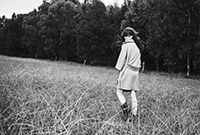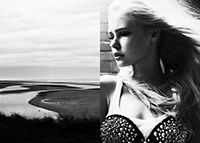By Jerome LEE
If you don't already know, Ai Weiwei is probably the most (in)famous contemporary Chinese artist. Having dabbled in sculpture, installation, architecture, curating, and photography amongst others, collaborated with Swiss architects Herzog & de Meuron on the Beijing National Stadium for the 2008 Olympics, having his installations showcased at the Venice Biennale are just some of his many accolades. His often politically-charged works reflects his harsh criticisms on the Chinese government, which, naturally, did not sit too well with the latter and even saw his arrest on 3rd April 2011 at the Beijing Capital International Airport.
All that aside, Ai Weiwei may have been the most well-known, but there are others who have made a name for themselves in China and around the world. Here are some of our top picks.
YUE MINGJUN
Born in the Heilongjiang province of China but based in Beijing, Yue Mingjun's paintings are instantly recognisable. The inspiration for his signature Cheshire-cat-smile-and-receding-hairline motif came from seeing fellow artist Geng Jianyi's China/Avant-Garde show in Beijing, and is now the centrepiece for every single one of his artworks. His style is often referred to as Cynical Realism, an art movement initiated not mainly as an art form/style, but rather a movement indicative of a desire for social change in China.
ZHANG HAIYING
Like Yue, Zhang Haiying is also based in Beijing. One of his most famous bodies of work is the Anti-Vice campaign series, an exploration of the Chinese Government's crackdown on prostitution and pornography. The bold red colours give rise to the mood of lust and passion usually found in brothels, and the contorted bodies of women reflect the sorrow and scorn suffered by these women in the prostitution industry. Zhang's works have been showcased in prestigious venues such as the SCOPE Art Show in Basel and the Willem Kerseboom Gallery in the Netherlands.
CAI GUOQIANG
Cai Guoqiang's innovative use of gunpowder in his works aim to foster the sense of spontaneity, and to confront the suppressed artistic freedom in China. Initially using both oil and gunpowder in his early works, Cai has gone on stage his signature 'gunpowder explosions' outside galleries. Drawing inspiration from presumably Chinese narratives such as fengshui, shanshui paintings and Chinese medicine, Cai cited Mao Zedong as an inspiration to all artists in his generation for his 'utopian romance and sentiment'.
XU BING
Xu Bing, like Ai Weiwei, moved to the United States for the country's artistic freedom and expression. His interest in words, language and how both affect our understanding of the world is reflected in works such as Tian Shu (translated into Book from Heaven), an installation of 4000 characters that seem to mimic Mandarin characters but are not - a critique of human's approach to language. Like many Chinese artists, Xu Bing's work is politically-charged, critiquing the cultural and linguistic reforms initiated by Mao Zedong and the Chinese Communist Party.
CHEN QIULIN
Hailing from the Hubei province of China, Chen Qiulin's works addresses her concerns about the urbanisation of China's rapid development. One of her works, 'Tofu-100 Chinese Surnames', sees her using tofu to spell the 100 most common Chinese surnames in China. This installation is meant to explore the original, the everyday, more so made impactful by using tofu, one of the most common food staples in China. It may been seen as a huge waste of tofu, but it has surely made its impact among audiences.
Top Link Bar
SEARCH
Newsletter
Labels
How much print media do you purchase in a month?
Archive
DISCLOSURE
All images and content on this site, unless otherwise indicated, is owned or licensed by Anue Management Pte Ltd 2013-2014 and is protected by copyright laws and regulations.
Content that you may find offensive, indecent or objectionable or any other, in this respect, is viewed at your own discretion.
Content that you may find offensive, indecent or objectionable or any other, in this respect, is viewed at your own discretion.
Powered by Blogger.
ABOUT ANUE MGMT
Anue Management & Studios is a fashion, beauty and lifestyle photography & videography service & creative agency homed within a unique industrial-styled building on the outskirts of Singapore's CBD. We provide clients with visual imaging services, photographic studio hire and event space rental. Anue Creative is the online home to all our inspired outlets such as fashion, beauty, style, travel, portraits & exclusive interviews.
Contact
Have any thoughts or feedback? Want to find out more about what we can do for you? Email us!
Photo Diary



 Archive personal folio by Anue Director Elvina Farkas
Archive personal folio by Anue Director Elvina Farkas
Our Clientele












































0 comments:
Post a Comment